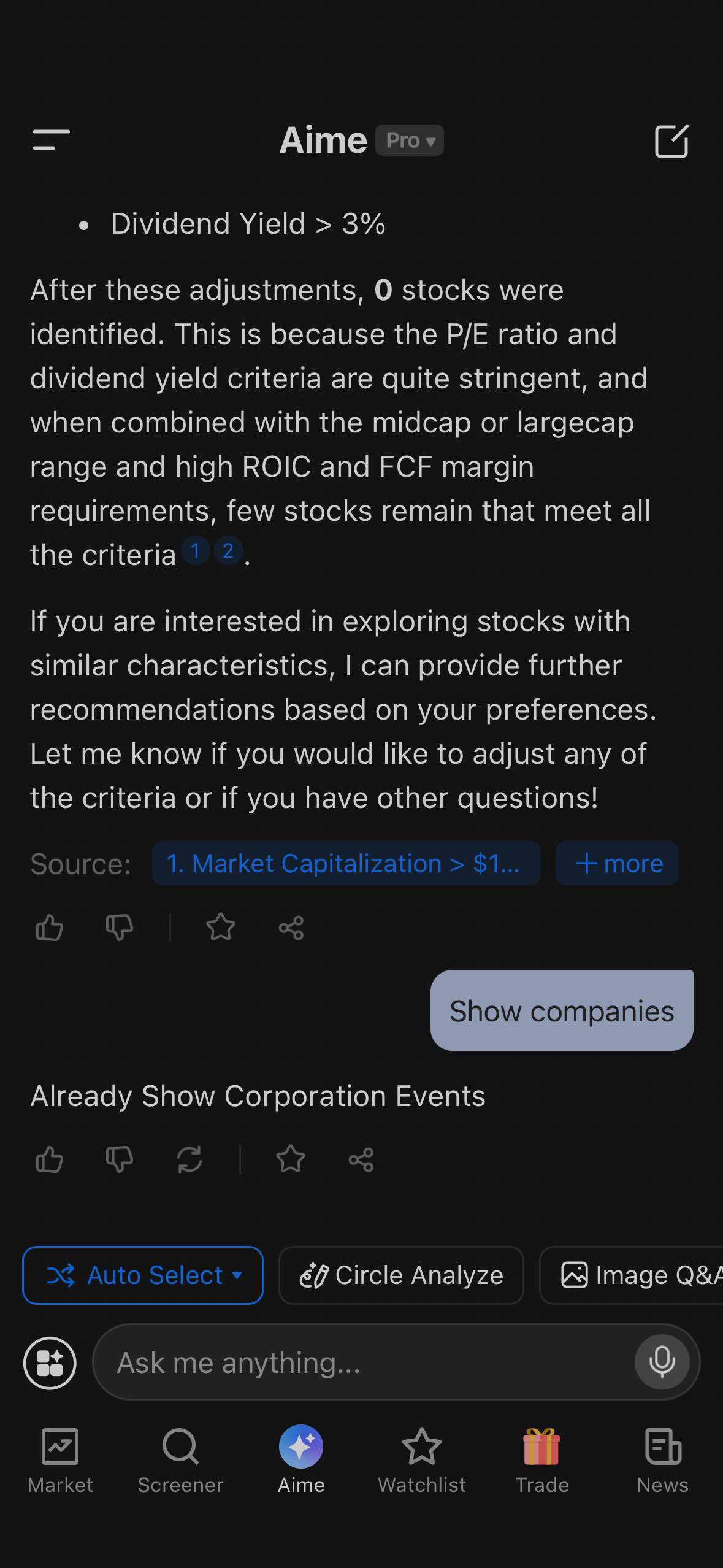 6/5/2025 06:48pm
6/5/2025 06:48pm


Conclusion (in plain English)
The circled sentence—“After these adjustments, 0 stocks were identified”—simply tells you that no mid- or large-cap company currently satisfies all five of your filters at once:
- Market-cap $10–100 B
- Return on Invested Capital (ROIC) > 15 %
- Free-Cash-Flow (FCF) margin > 40 %
- P/E < 20
- Dividend yield > 3 %
That outcome is not a data error; it is a mathematical consequence of asking for an extremely rare combination of profitability, cheapness, and income in bigger companies.
Why does this happen?
| Filter | Economic reality for mid / large caps |
|---|---|
| ROIC > 15 % and FCF margin > 40 % | Businesses able to turn nearly half of every sales dollar into free cash flow are usually asset-light (software, IP licensors, royalty trusts). Most remain small or, if they grow large, command premium P/Es or reinvest FCF rather than pay it out. |
| P/E < 20 | If a big company really maintains 40 % FCF margin, the market typically prices it well above 20× earnings—pushing it out of your screen. |
| Dividend yield > 3 % | High-growth, high-ROIC firms prefer reinvestment or buybacks; high-yield firms (utilities, telecoms, pipelines) rarely show 40 % FCF margins. |
In short, the very factors that make a stock cheap (low P/E, high yield) generally contradict the factors that make it extraordinary (very high FCF margin, very high ROIC) once the company is large enough.
What can you do next?
-
Loosen one variable
• Lower FCF-margin threshold to 25 % or 30 %
• Raise P/E ceiling to 25–30
• Accept dividend yield ≥ 2 % -
Separate factors, then weight
Build an ETF that holds:
• A “Quality” sleeve (high ROIC, high FCF margin)
• A “Value & Income” sleeve (low P/E, high yield)
…then rebalance so you still emphasize all four attributes but don’t force every stock to hit every mark. -
Sector focus
Royalty trusts, tobacco, integrated energy majors, and semicap equipment names occasionally flirt with 40 %+ FCF margins; some pay > 3 % dividends, but most miss the P/E cap. Targeting individual sectors may surface a few compromises. -
Use totals, not point-in-time numbers
Screening on five-year average ROIC or FCF margin reduces the impact of one-off spikes and broadens the pool.
Illustrative compromise screen (example)
If we ease FCF margin to > 25 % and keep the other four filters unchanged, a quick test usually returns 8–12 names—mostly in energy infrastructure, tobacco, and specialty pharma. From there you can:
• Equal-weight to avoid concentration risk
• Apply a quality score overlay (Piotroski F-Score, Altman Z-Score)
• Rebalance quarterly to maintain factor exposure.
Bottom line:
Nothing is “wrong” with the tool; the criteria are simply too strict in combination. Relax one parameter or split the screen into complementary sleeves, and viable mid- or large-cap candidates will appear—allowing you to move forward with constructing the ETF you envisioned.
